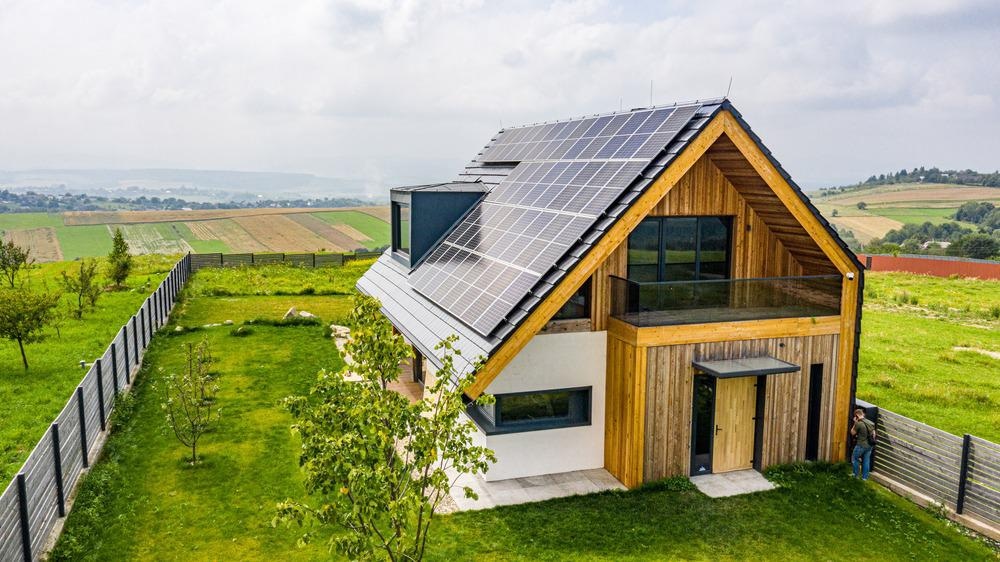An eco-house is a house that is designed in such a way that it is environmentally friendly. It is built with consideration of technology and materials that reduce both its carbon footprint and energy use.

Image Credit: Vgreek/Shutterstock.com
Multiple methods can be used to measure the sustainability of eco-homes, which include water conversion, reduction of waste as a result of recycling materials, the control of pollution, energy and its conversion, as well as the level of carbon dioxide emissions.
Some of the characteristics that are pertinent to eco houses include rainwater harvesting, composting toilets, solar energy panels, small wind turbines or green electricity from suppliers such as H.E.P (Hydroelectric power), geothermal heating systems for the house, and green roof gardens which help to regulate the temperature of the house and capture carbon dioxide from the atmosphere.
Eco-homeowners ultimately pay little or less for energy utility bills. The current market is hardly meeting the demand for housing and therefore is significantly overpriced and poorer in quality. To combat the growing issues, designers are exploring alternative materials and innovations.
Construction Materials that are Commonly Used for Eco Homes
Timber is the primary building material for eco-housing. This is because trees can be grown specifically for timber production.
Lime is another popular material that can be used in the production of cement for construction and has been utilized for thousands of years in some areas around the world. Although energy and carbon dioxide is emitted during its production, lime slowly returns to limestone in a process that uses up atmospheric carbon dioxide.
Exploring Unconventional Eco-Friendly Materials
Bamboo is an ancient natural material that has been used for thousands of years and can be used for the construction of eco-housing. Bamboo is one of the fastest-growing plants in the world, making it ideal to supplement the construction of eco-houses. Other characteristics of bamboo include its enormous strength, its flexibility, and its lightweight nature.
Bamboo is a viable option for eco-housing development, but a few hurdles have yet to be addressed.
The Drawbacks of Bamboo-Reinforced Concrete
Shipping containers are now being used to create homes by those who see them as an opportunity for an efficient and quick way to build homes. A very good example of a house built from a container is the PV14 in Texas USA which is a 3700 sq feet three-bedroom house with a swimming pool. With an excess of over eleven million unused containers that just sit idle all around the world, there exists a potential to build more eco homes using these containers.
Innovating with Shipping Containers
Considering Rammed Earth as A Sustainable Alternative
While it is still not very popular in the United Kingdom, rammed earth usage and exploration are on the increase, especially with environmentally aware architects. Rammed earth is one of the earliest sustainable building materials that dates its use back to 500 BCE in China.
In the United Kingdom, building using rammed earth was only introduced in the late 18th century and early 19th century as a result of the revival of rammed earth building that was happening in France.
Some of the benefits of using rammed earth for eco-house buildings are that the buildings will naturally exhibit fireproof capabilities, reduce carbon emissions, exhibit stronger load-bearing capabilities, and are additionally aesthetically pleasing to the eye.
Rammed earth structures endure well, and this is evident today from the presence of ancient structures that are still standing all around the world.
Analyzing Future Implications for the Housing Market
In summary, eco-housing has the potential to be a viable housing alternative that would benefit both the environment and the people who occupy them. Economic advantages such as cheap utility bills will also contribute to the fight against climate change and global warming as a result of the reduction of carbon emissions.
In order for this to happen effectively, the following issues concerning eco-housing will have to be addressed. Eco homes are incorrectly assumed to cost more than the construction of a conventional home. Encouragement of eco-homes remains a difficult task that is mainly opposed due to a lack of knowledge, dependence on technological fixes, and a certain expectation of convenience and comfort.
Governments can also be partly blamed for the lack of the development of mass eco-housing projects. Many government policies and agendas prioritize technological approaches as opposed to eco-housing developments. A good example is Britain, where eco-housing is being resisted by builders and developers.
It is quite clear that the knowledge and technology are readily available to allow eco-housing to progress, yet it still faces resistance. It would be appropriate to think that other unknown issues are also hindering its growth. Political, economic and land barriers to the growth of eco-housing will have to be overcome for eco-housing to greatly progress.
References and Further Reading
Ricci, P., 2021. Are eco homes the future? [online] Barbour Product Search.info.Available at: <https://www.barbourproductsearch.info/are-eco-homes-the-future-blog000213.html>
Sharman, J., Sharman, J., McPartland, R., Sharman, J., McPartland, R. and McPartland, R., 2021. Alternative housing: a different approach to materials, styles and community thinking (Part one). [online] NBS. Available at: <https://www.thenbs.com/knowledge/alternative-housing-a-different-approach-to-materials-styles-and-community-thinking-part-one>
Pickerill, J., 2021. Eco-Homes for all: Why socio-cultural matters in encouraging self-build eco-housing. [online] Eprints.whiterose.ac.uk. Available at: <https://eprints.whiterose.ac.uk/124742/3/Pickerill%20chapter%20Self-build%20homes%202016_online.pdf>
Disclaimer: The views expressed here are those of the author expressed in their private capacity and do not necessarily represent the views of AZoM.com Limited T/A AZoNetwork the owner and operator of this website. This disclaimer forms part of the Terms and conditions of use of this website.